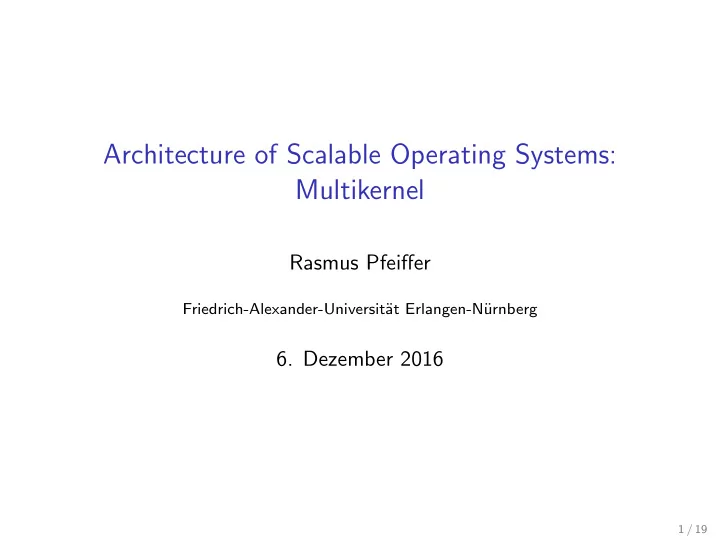

Architecture of Scalable Operating Systems: Multikernel Rasmus Pfeiffer Friedrich-Alexander-Universit¨ at Erlangen-N¨ urnberg 6. Dezember 2016 1 / 19
Table of Contents Shared Memory vs Message Passing Inter-Process Communication Multikernel Model Barrelfish 2 / 19
Description Shared Memory uses data structures at well known places in memory to communicate between CPU cores. Message Passing uses explicit messages to communicate between CPU cores. 3 / 19
History Shared Memory and Message Passing are duals [3] In 1978 Lauer and Needhalm argued, that it depends on the hardware, if shared memory or message passing is faster. 4 / 19
Current Situation Comparison of the cost of updating shared state using shared memory and message passing [1] 5 / 19
Kernel-Based IPC Kernel-based inter-process communication (IPC) is limited by the cost of invoking the kernel and reallocating a processor from one address space to another [2]. 6 / 19
User-Space Remote Procedure Call (URPC) ◮ Messages are sent directly between address spaces. ◮ Unnecessary processor reallocation between address spaces is eliminated. ◮ When processor reallocation is needed, the overhead is reduced. 7 / 19
URPC - Assumptions ◮ Client has other work to do ◮ The server has, or will have, a CPU core available. 8 / 19
Multikernel Model 1. Make all inter-core communication explicit. 2. Make OS structure Hardware-neutral. 3. View state as replicated instead of shared. 9 / 19
Barrelfish structure 10 / 19
CPU driver ◮ single threaded ◮ controls: APIC, MMU, etc ◮ shares no state with other cores ◮ specialized for CPU architecture 11 / 19
Monitors ◮ processor-agnostic ◮ manages system-wide state 12 / 19
Inter-Core Communication 13 / 19
Process structure ◮ processes consist of dispatcher objects ◮ dispatcher objects are scheduled by CPU driver 14 / 19
Memory Management Memory management is performed explicit in user level: 1. acquire memory for page table 2. insert page table in root page table 3. acquire more memory and insert in page table 15 / 19
Performance I - compute-bound workloads 16 / 19
Performance II - IO workloads Webserver: ◮ static content ◮ Linux: 8924 requests per second ◮ Barrelfish: 18697 requests per second ◮ dynamic content ◮ 3417 requests per second 17 / 19
Questions ANY QUESTIONS? 18 / 19
References A. Baumann, P. Barham, P.-E. Dagand, T. Harris, R. Isaacs, S. Peter, T. Roscoe, A. Sch¨ upbach, and A. Singhania. The multikernel: a new os architecture for scalable multicore systems. In Proceedings of the ACM SIGOPS 22nd symposium on Operating systems principles , pages 29–44. ACM, 2009. B. N. Bershad, T. E. Anderson, E. D. Lazowska, and H. M. Levy. User-level interprocess communication for shared memory multiprocessors. ACM Transactions on Computer Systems (TOCS) , 9(2):175–198, 1991. H. C. Lauer and R. M. Needham. On the duality of operating system structures. ACM SIGOPS Operating Systems Review , 13(2):3–19, 1979. 19 / 19
Recommend
More recommend